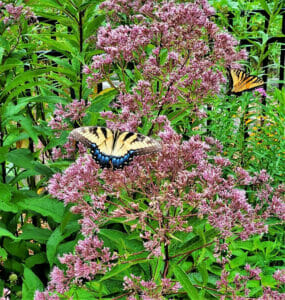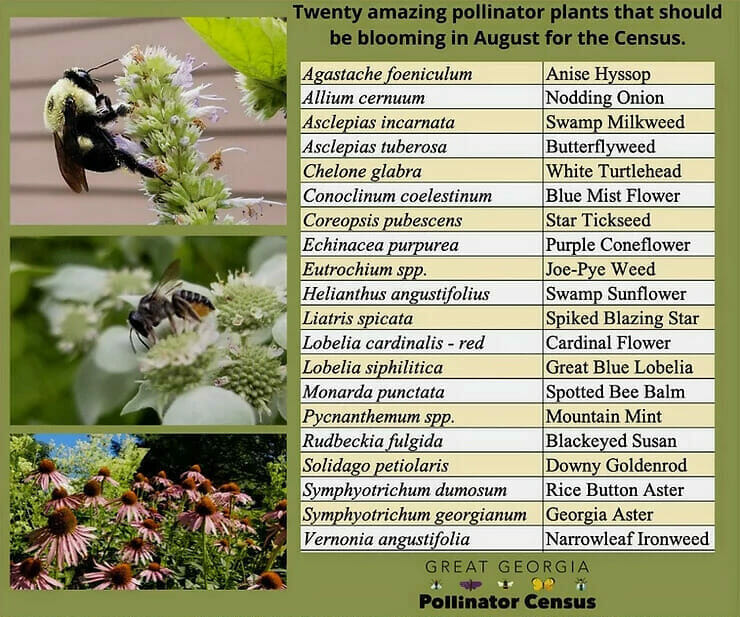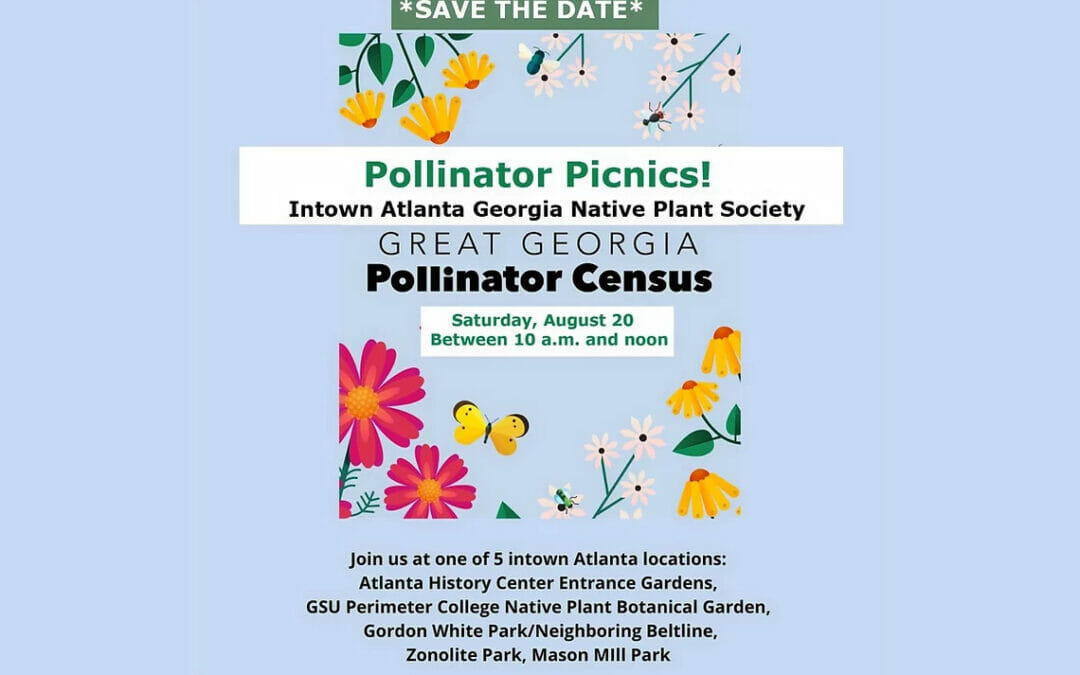What is the Great Georgia Pollinator Census Count?
The Great Georgia Pollinator Census count (GGPC) is a citizen science project coordinated by the University of Georgia Extension to encourage Georgians to learn more about insects and be open to planting a pollinator habitat with native plants. It is also designed to be straightforward enough so non-scientists can help researchers by collecting data and documenting pollinator numbers in Georgia. It only takes 15 minutes, and you can even do it more than once! In 2019 more than 4,600 counts were uploaded, documenting more than 131,000 insect visits tallied from 134 Georgia counties including 135 schools! The helpful UGA site has instructions and a short video showing how to participate in the count and even lesson plans for teachers that align with Georgia Performance Standards.

Why should I participate in the Georgia Pollinator Census Count?
We can turn the feeling of helplessness about the alarming insect decline and contribute to a healthier ecosystem where we live by participating in the GGPC. In addition to adding data about pollinators, the census count has been shown to increase appreciation for insects, awareness about their habitat needs and create more excitement and interest in planting native plants to attract insects. Children who participate in the count also deepen their understanding of pollinators! So far at least 525 new pollinator gardens have been created as part of the project.
What is a Pollinator Picnic?
A pollinator picnic may sound like a gathering of pollinators feasting on native plants, but this year a pollinator picnic is one of five locations around Atlanta where the Intown Atlanta Chapter of the Georgia Native Plant Society (Intown GNPS) has chosen as a site for people of all ages to participate in the GGPC. Everyone who wants to participate in the count is encouraged to bring a friend, a picnic lunch, enjoy nature, and learn more about how to attract pollinators where they live by using native plants.
When are the Pollinator Picnics?
The Pollinator Picnics are all on Saturday, August 20 from 10 a.m. to noon.
 Do I need to register or pay to attend a specific Pollinator Picnic?
Do I need to register or pay to attend a specific Pollinator Picnic?
No, the Pollinator Picnic are free for everyone – you can just pick one of the sites and show up!
What do I need to bring to the Pollinator Picnic?
Bring yourself and friends or family members! All the supplies needed to participate in the GGPC will be available at each site. If you want you can bring a picnic, drinks, and foldable chairs or a blanket to watch the pollinators or eat your picnic. For some of the sites, there are also places nearby to grab a bite of food.
I don’t know where to go, what makes each Pollinator Picnic site unique?
The five Pollinator Picnic sites were chosen because they are in different parts of intown and have an area with native plants where the pollinator count can take place. If you’re on Facebook and join the Intown Atlanta Chapter of the Georgia Native Plant Society page, each site has an event page with more information. Spread the word by sharing the Pollinator Picnic posts or the site you plan on visiting in your own online circles!
The Five Pollinator Picnic Sites are:
1) Atlanta History Center Entrance Garden The count will take place in the Atlanta History Center’s Entrance Garden at the front of the museum. Most of the plants in this wildlife and pollinator friendly garden are Georgia native plants with an emphasis on grasses echoing the look of American prairies. Parking is free in the AHC main parking deck. Paid food and drink options are available on site, with Brash Coffee opening at 8am and Souper Jenny open for lunch. Museum admission is not required to enjoy these refreshments. There is plenty of space to eat at the 60-foot tree table made from a white oak that had sprouted on the grounds of what is now the Atlanta History Center back in the 1880s. Atlanta History Center has generously offered discounted admission for people who participate in the pollinator count. Valid for same-day admission. Counting will take place 10-11, and from 11-12 there will be a guided nature walk led by AHC Horticulture staff. Counters can participate in the guided nature walk with the price of discounted admission.
2) Gordon-White Park and adjacent Westside section of the Beltline Gordon-White Park, a traditionally landscaped city park in Atlanta’s Historic West End, is home to an open greenspace with winding pathways, landscaped garden bed, and walls and benches for relaxing and eating. The adjacent Westside section is planted with native plants. This Pollinator Picnic site will offer a great opportunity to contrast pollinator habitats. The Pollinator Picnic host will lead a brief tour along the Beltline at noon and if you like, you can join her and others and have a “picnic” at one of the local spots. If you prefer, you can bring your own picnic to enjoy at the park. After lunch explore the neighborhood – stop on Peeples St. to experience the Hammonds House Museum, which celebrates the cultural diversity and legacy of artists of African descent. Just around the corner on Ralph David Abernathy Blvd. sits the Wren’s Nest, historic home of author Joel Chandler Harris.
3) GSU Perimeter College Native Plant Botanical Garden The native plant garden areas at the GSU garden are nestled just behind the campus on 4 acres of land in South Decatur. There are over 4000 species of native, rare, and endangered plants indigenous to the Southeast and US that demonstrate the use and culture of US native plants in Georgia. Some of the volunteers on site for the Pollinator Picnic are Dekalb County master gardeners who help maintain this unique garden.
4) Mason Mill Park The count site at Mason Mill Park will be the new pollinator habitat near the Old Decatur Waterworks. Park near the DeKalb Tennis Center in Mason Mill Park and follow signs for ½ mile along the South Peachtree Creek PATH to reach the count site. Once you’re done with the count and your picnic, explore the 120-acre forest with a network of trails for hiking and biking. The forest is also the location of the old Decatur Waterworks, which is on the National Historic Registry. There is also a large playground for kids near the tennis courts.
5) Zonolite Park South Fork Conservancy worked with a coalition of federal, state and local organizations (including GNPS) to turn an industrial wasteland contaminated by asbestos into a 13-acre urban sanctuary now called Zonolite Park with a community garden called Nickel Bottom. Now, nature lovers find peace walking the trails through the woods in the park and young families play at the edge of the creek that runs along the length of the park. If you join this site for the count, you will undoubtedly be treated to seeing one of the rare American bumblebees that live in this park where they have an ideal habitat. For this count there will a nature walk through Zonolite woods, handouts for kids to explore nature at the park, materials to learn about ways to create a more pollinator friendly yard, and even a sweet treat to go with your picnic. Meet at the pavilion in the Nickel Bottom Community Garden area. The main parking lot is located on Zonolite Place, near the intersection of Johnson Road and Braircliff in DeKalb County.
 I’ve never done the Great Georgia Pollinator Census count, how do I do it?
I’ve never done the Great Georgia Pollinator Census count, how do I do it?
The Intown GNPS will have volunteers available at all the sites to give instructions for participating in the count. Whether you’re doing the count on your own or joining one of the Pollinator Picnic sites and want to know what to expect, the steps for counting are:
-Find a popular native pollinator plant that has lots of insect activity on it.
-Set a phone timer for 15 minutes.
-Count how many insects land on any part of one plant and record it on the pollinator count sheet. Count each time an insect lands on the plant, even if it is an insect that left and came back. The five Pollinator Picnic sites will also have counting and identification guides with photos and identification tips.
-If you are attending one of the Pollinator Picnics, there will be a box to turn in your counting sheet for Intown GNPS volunteers to record it. (Go to the GGPC website and record the findings if you are doing this on your own. The form to record it will be available online on August 20 and stay up for a few weeks after the census.)
-Cute stickers of completion will be available at each Pollinator Picnic site for the children or the child in all of us who wants a sticker!
What if I can’t make it to one of the Pollinator Picnics but still want to participate in the Great Georgia Pollinator Census?
If you can’t join us at one of the Pollinator Picnic sites, you can participate in the count anytime on August 19 or 20 in your own yard, local park where there are native plants, or if you live Intown Atlanta, you can view pollinators at any of the following places for free:
Arabia Mountain
Beecatur Willow Lane Pollinator Habitat
Blue Heron Nature Preserve
Hawk Hollow (a Wylde Center greenspace)
The Kendeda Living Building at Georgia Tech
The Preserve @ St. Marks
Tucker Butterfly Garden
Woodlands Garden
Wylde Woods
Is there a bigger picture to this count?
Pest control companies have made insects the enemies and we need to fight back against this characterization. By including all insects, not just butterflies and honeybees, citizen science projects like the GGPCC create the kind of excitement and positive attitude towards insects that is needed to change the narrative about the value they offer our ecosystem. You don’t have to be in Georgia to participate in the count, but if you live intown Atlanta, please share this post in your social media networks to help save our precious insects!

